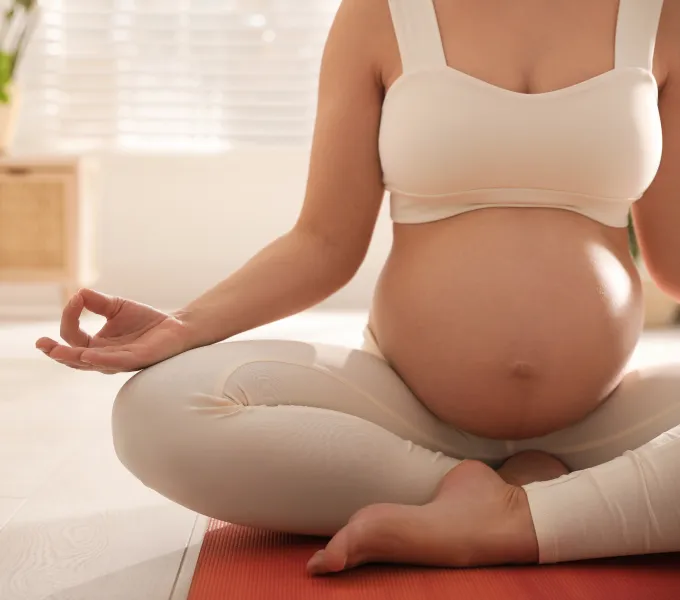
Why Perineal Massage is 100% Worth Doing
Let’s get right to the real talk: Inserting a finger into your vagina and massaging your perineal body (the muscle and tissue between the vaginal and anal opening) can feel like a lot. The setup alone — stripping from the waist down, making sure you’re warm and comfortable, finding the lube, locking the door if you’re worried about privacy — can be a major barrier to getting it done. It may even feel uncomfortable. So you might be wondering: Is it really worth the trouble?
It is. Allow us to explain why, starting with what happens when you skip it. Around 85% of women will experience some amount of perineal trauma during vaginal delivery. The force created by pushing combined with the sheer amount of stretching required to let a baby pass makes injury to these tissues very common.
When the perineal body is injured, it can lead to things like stress urinary incontinence, stool leakage, painful intercourse, and pelvic organ prolapse. The bright side: As part of a well-rounded birth prep training routine, perineal massage can help reduce delivery-day pain and injury and lower your risk of postpartum symptoms. And there’s more — perineal massage can prep you for the sensations of childbirth, preventing you from tensing up at the very moments when you need to relax and let that baby out!
The Benefits of Prenatal Pelvic Massage
During a vaginal delivery, the perineal tissues and muscles naturally lengthen and stretch, making room for the birth of your baby. According to research, perineal massage can assist with this natural opening of your tissues, improve their healing, and leave you less likely to experience injury (including tearing), or postpartum pelvic floor symptoms.
How does it help? The goals of perineal massage are to improve blood flow and flexibility of the tissues of the vaginal entrance and perineum. Stretching these tissues in the weeks before delivery can also be incredibly empowering, preparing you for the feel of crowning (when the baby’s head puts pressure on the vaginal entrance), and helping you get accustomed to the stretch sensation which can minimize a tendency to tense your muscles against the sensation during birth. It may also help manage any fear you may have associated with the possibility of tearing.
When to Start Prenatal Pelvic Massage
It's typically considered safe to start perineal massage around the 35th week of your pregnancy. Aim to complete the stretches at least once a week at that point, and even more often in the weeks leading up to your birth.
While perineal massage is recommended for most pregnant individuals, it isn't safe for everyone. Below are some instances in which you would want to avoid perineal massage or check in with your physician or obstetric healthcare provider first:
- You have preterm labor
- You have an incompetent or insufficient cervix
- You have had premature rupture of membranes
- You’re having vaginal bleeding during pregnancy
- Your MD puts you on “pelvic rest”
- You have a vaginal infection or herpes lesions
Tips to Know Before You Start
Perineal massage is a tad of a misnomer as you are really stretching your tissues, not massaging them. The idea is to use either your finger (pointer finger or thumb usually work best) to stretch the bottom tissues of the vaginal opening, perineum, and vagina. Your partner can also pitch in and do this massage for you.
Some general tips to get you started:
- Good positions for perineal massage include seated on a bed with pillows supporting your back and your knees bent up to your chest and relaxed down to the bed, in a warm bath, or lying on your side with your knees bent and a couple of pillows between your knees. No position is better than the other, just do what makes the most sense for you or whoever is helping you, and your growing belly!
- Use lube! Once you’re comfortable, you’ll want to use clean and lubricated fingers (any lube with clean, vagina-friendly ingredients will do — check out this blog for some recommendations)
- Insert your fingers into the vaginal entrance an inch or two. You’ll be stretching the lower portion of your vaginal opening, pelvic floor muscles, and perineal tissues, as this area will sustain the greatest amount of stretch and pressure during delivery.
- It may be helpful to think about your vaginal opening in terms of a clock face, with six o’clock being straight down towards your anal opening, and 3 and 9 out toward your thighs. You’ll want to stretch in all directions from 3-9 o’clock to stretch and soften these tissues.
- When you massage your perineal body, make sure that the massage is gentle in order to avoid bruising or irritation to your tissues.
There are many great tutorials available with more specific guidance on perineal massage. Check out this website for more instructions, or make an appointment with one of the pelvic PTs at Origin to get personalized advice. They are experts in birth prep and will help you with a birth preparation program that is uniquely designed for you, including perineal stretching instructions and coaching.




